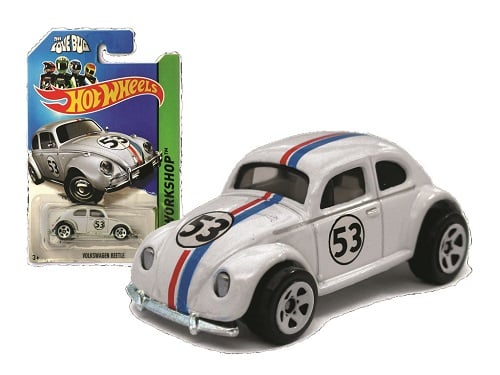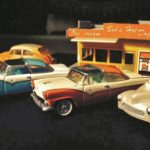by Jessica Kosinski
Tin Toy Cars
Since this issue is all about toys from the attic, let’s take a peek at two of the most well-known names in toys, Hot Wheels and Matchbox. Most of us had these cars as kids. Those who still have them in the attic might be sitting on quite a valuable find. But as with most anything, the value may depend on a lot of factors.
The Early Days of Matchbox Cars
The Matchbox line was founded in 1953 by Lesney Products of England. The company got its name from a combination of the names of its two founders, Leslie Smith and Rodney Smith, who were not actually related to each other. The cars themselves got the Matchbox name because they were originally sold in boxes that were about the size of matchboxes.
Original Lesney Matchbox cars were mainly focused on working vehicles that had basic metal bodies with simple axles and frames. Early vehicles mainly consisted of basic cars, but soon advanced into trucks, construction equipment, and freight vehicles. Lesney quickly captured the attention of children all over with those working-style vehicles. They also often sold vehicles in boxes that weren’t marked, generally at drugstores. So, parents could buy their kids an inexpensive surprise. That tactic caught on quickly and kept Matchbox cars at the forefront of the toy car industry for quite a while.
Hot Wheels Enters the Scene
The 1950s and 1960s was the birth of a major phenomenon in the actual vehicle industry. Many people began driving muscle cars and other cars that were build for power and speed, such as the Mustang and the Corvette. Teenagers were particularly fond of street racing those cars, and soon toy companies started taking notice of the fact that younger kids were enamored with them as well.
The Competition Between Hot Wheels and Lesney
Very soon after Hot Wheels came on the scene, Lesney realized that it had to start adapting to the new competition. Hot Wheels cars used torsion-bar suspension and Mattel also started releasing custom “Red Lines” tracks for them to run on. That made them very fast, which kids loved. That was not good news for Lesney. In fact, the entire Matchbox line might have died out, had they not been able to think on their feet and make some major changes.
To avoid going by the wayside, Lesney soon released a competitive line of muscle cars, including Corvettes and Mustangs, which all had revamped suspensions to make them run faster. That began to fuel the competition between the companies. For several years both brands released competing models and seemed to thrive. However, Lesney eventually lost that battle. They sold the Matchbox line and, after switching hands a couple times, it was purchased by Mattel in 1997. Mattel continues to release new cars in both the Matchbox and Hot Wheels lines to this day.
The Value of Matchbox and Hot Wheels Cars
When considering the value of Matchbox and Hot Wheels cars, buyers and collectors need to factor in several things. The first factor is the purpose of the car. There are some people who buy loose Matchbox and Hot Wheels cars at antiques shops and flea markets simply for the joy of sharing them with their kids and grand kids. While those cars have a lot of “fun value,” they aren’t valuable to collectors.
There are also some artists and photographers who use miniature cars in scale model scenes to make them look realistic. This type of miniature photography is quite popular, and the artists who do it take it very seriously. They often want a model car from a very specific year to make their scene complete, which means that they might be willing to pay more money than an average person would for a Matchbox or Hot Wheels car in less than perfect condition.
Top Cars to Look For
In terms of monetary value, the earliest cars under both brands tend to be the most valuable. For instance, the Matchbox 1953 Aveling Barford Road Roller, which was one of three cars in Lesney’s first Matchbox set, is widely considered to have the highest price tag. However, other Matchbox cars can also fetch a high sum, including cars that had factory errors, such as a 1965 BP Dodge Wrecker that was manufactured in “reverse color,” which sold on eBay for a whopping $8,499 a couple years ago.
As for Hot Wheels, color can sometimes make all the difference, in addition to age and condition. Many models were released in multiple colors. Take the 1971 Purple Olds 442, for example. Most cars of that model were magenta, not purple, making the purple one worth thousands of dollars today, especially in mint condition. Among the many other valuable Hot Wheels cars is the Hot Wheels Real Riders A-OK, which sold in its blister pack in mint condition for over $800 on eBay this year.
Of course, these are just a handful of examples. There are thousands of Hot Wheels and Matchbox cars in attics and basements across the country just waiting to be discovered or rediscovered, not to mention at antiques shops, flea markets, yard sales, and other venues. So, whether you plan to play with them, display them, or resell them, you should definitely keep your eyes peeled for these little treasures.
Special thanks goes to Matchbox and Hot Wheels collector, photographer, and artist Stephanie Bissonnette of Bolton, Massachusetts, who can be contacted at Facebook.com/sjbissonnette.









Related posts: